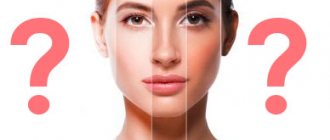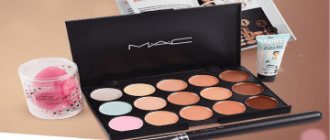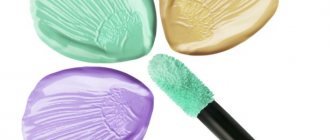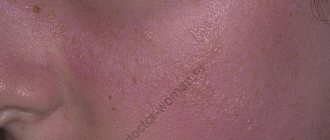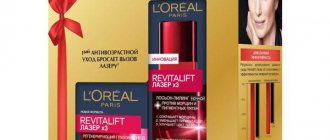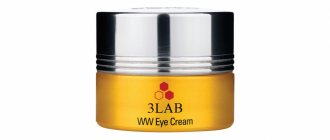Updated: 04/23/2021 11:35:07
Expert: Ekaterina Alekseevna Savitskaya
Every girl dreams of make-up on her face looking beautiful and natural, emphasizing her strengths and hiding her flaws. This can only be achieved if, when choosing cosmetics, you pay great attention to the features and individual characteristics of the skin on your face. Foundation, lip gloss, blush, even eye shadow can simply not match your complexion and ruin your overall look. Expertology.ru journalists learned all the information about skin tones, what undertone it might have, and what these indicators influence.
Features and characteristics of the epidermis - tone, subtone
The concept of epidermal color consists of two aspects - tone and subtone (undertone). Tone, that is, the color itself, shade, can change during a person’s life, and more than once. For example, in winter the skin can be ivory-colored, and in summer a woman tans and her face turns bronze.
The undertone of the skin does not change; it is determined by how much the tissues located below “shine through” the epidermis. It is enough to define it once, and this information will always be relevant. You've probably noticed that some women's skin looks yellowish or bluish. This is the undertone - in the first case it is warm, in the second it is cold. However, an undertone can also be neutral if it combines both warm and cold shades. It is precisely because of the characteristics of the skin's undertone that some decorative cosmetics may be suitable for some girls and completely unsuitable for others. For example, if you apply a foundation of a light but warm color to a very light epidermis with a bluish cold undertone, the result will be unsatisfactory, the face will seem somehow gray and tired.
You can most accurately determine the shade of the epidermis using a colorimeter - a special portable device. Large stores and supermarkets of decorative cosmetics are often equipped with such devices. But if you don’t have the opportunity to visit such an establishment, you can find out the shade and undertone of your skin yourself, at home. You just need to prepare for the procedure so that the results are as accurate as possible.
What determines the color of the skin?
The color of human skin is determined by a special pigment - melanin, which is produced by special cells - melanocytes. Melanin production depends on the following factors:
- Genetic predisposition.
- Ultraviolet radiation intensity.
- Gender of the person (the skin of female representatives is always slightly lighter than that of males).
- Time spent in sunlight.
- The amount of hormones that stimulate the production of melanin and ACTH.
However, there are people in the world who completely lack melanin in their skin cells. They are called albinos. It is contraindicated for such people to stay in the sun for a long time, as they are immediately susceptible to strong radiation.
What pigment determines intensity?
In addition to melanin, the shade of a person’s skin is determined by several more pigments, which also determine the tone and color type of the dermis:
- Carotene. Characteristic of all skin colors, it is responsible for the production of yellow shades. It is difficult to visually determine the level of carotene in the skin, since it is hidden by melanin. Residents of the eastern part of Asia have the highest levels of carotene, which is why they have a yellowish tint to their dermis.
- Hemoglobin. Responsible for giving the skin, in particular the cheeks, a pinkish tint. Hemoglobin is most noticeable in people with fair skin.
The results of color analysis of the dermis depend on the amount of each of the three pigments in the body.
Short preparatory stage
How to determine the shade of the facial epidermis - preparation for the test:
- Wash off makeup, dirt, dust from your face.
- After washing your face, wait 15 minutes for the color of the epidermis to normalize. Immediately after the hygiene procedure, the skin may be slightly pinkish or too pale due to drying with a towel or the temperature of the water. If you have recently returned from outside, especially from the cold, you also need to wait until the blush or extreme pallor goes away.
- Remove jewelry from your ears and neck, as they will distract attention and interfere with perception.
- The hair on your head should be secured with a bandage or hidden under a scarf so that it does not fall onto your face, making it difficult to determine its shade.
The test should be carried out near a window, since artificial lighting can distort the color of the skin, giving it a yellowish or greenish tint.
Determining color and undertone - method 1
You will need a blank sheet of white paper. You can take regular A4 office paper. Stand in front of a mirror and hold the piece of paper to your face. First, determine how much darker the skin is than the paper. There are seven main colors of the epidermis, which manufacturers of decorative cosmetics focus on; you must understand which option your skin is closest to against the background of a white sheet:
- Very pale, almost porcelain, “ivory” or Very Fair.
- Pale or Fair.
- Medium, beige or Medium.
- Olive or Olive.
- Dark or Dusty.
- Tanned or Tan.
- Dark or Dark.
Without removing the paper from your face, determine whether your skin looks yellowish, bluish, or pinkish. In the first case, you have a warm undertone, in the second and third, you have a cold undertone.
If you have red spots on your face, especially large ones, areas of irritation or peeling, a large number of pimples or scars from them, it can be difficult to correctly determine the tone. But you can apply the paper not to your face, but to your neck; it will be the best “sample” for the test.
Why do you need to know this?
Many people often ask this question, not realizing how important a role skin tone plays in creating a look. It is important to know the color of your skin in order to:
- Choose the right decorative cosmetics, in particular eye shadow, blush, powder, lipstick.
- Choose the right shade of hair dye and even nail polish.
- Choose a harmonious wardrobe.
Obviously, knowing your skin tone will allow any woman to look much brighter and more attractive, so stylists and makeup artists strongly recommend starting work on your look by studying your own characteristics, and not fashion trends.
Determining color and undertone - method 2
To carry out the test, you will need gold and silver rings or earrings without unnecessary details such as stones and glaze. As well as small pieces of foil, both golden and silver. First you need to stand in front of the mirror and apply jewelry to your face one by one. You should try to understand what suits you better - yellow or white metal. If it's yellow, it means you most likely have a warm undertone. If it's white, then your undertone is cold.
But this method of determining the undertone is considered very subjective, since the perception can be influenced by your preferences, which metal you like best. Therefore, it is recommended to conduct another test with pieces of foil. Also apply them one by one to your face so that the foil reflects sunlight and gives a shine to the skin. You need to evaluate whether such a reflection makes the face more radiant, or, on the contrary, does it look dull and lifeless? If you don't notice much of a difference, you most likely have a neutral undertone.
Determination of color and undertone - methods 3, 4, 5 and 6
There are several other ways you can try to determine the undertone of your skin:
- Look at the skin on the inside of your elbow or wrist. The epidermis there is very thin and delicate, is not influenced by any extraneous factors, and veins should be clearly visible through it. You just need to look at them carefully and understand what color they are. If the veins appear greenish, this indicates that you have warm undertone skin. If your veins appear bluish, blue, or deep purple, then you have a cool type with a pinkish or bluish undertone. If some blood vessels appear blue to you and others green, or you simply have difficulty determining their color, then your skin has a neutral undertone.
- Think about how your skin reacts to direct sunlight in the summer. If you tan easily even after short exposure to the sun, you most likely have a warm undertone, caused by a large amount of melanin in the upper layers of the epidermis. If you are “snow white”, have difficulty acquiring a tan, and often get sunburned, this may indicate a cold undertone to your skin.
- Look at your hair on your head if its color has not been changed by dyeing, and also remember what color your eyes are. Cold undertone skin is typical for blue-eyed, green-eyed and gray-eyed girls. Warm - for women with brown and amber eyes. If the curls are chestnut or red, the undertone is most likely warm. And if you are the owner of platinum, light blond curls, you probably have cool skin.
- You can also try to determine the shade and undertone of the epidermis by what nationality you are. As a rule, warm skin tones are characteristic of Japanese, Chinese, Korean girls, Italians, Spanish and Arab women. And American, German, French, Norwegian and Russian girls mostly have a cold undertone. By the way, experts note that Indian and Chinese girls buy the most gold jewelry. But jewelry made of white gold, platinum and silver is in great demand among American and European women.
Determination of color type
A color type is a set of color characteristics of appearance that determine the classification of a person’s appearance into one of four types:
- spring;
- summer;
- autumn;
- winter.
The correlation of color types with the seasons is not accidental, because each period has its own special colors, unique only to this time. Moreover, the air temperature is not the determining factor here, but more on that later.
Participate in determining the color type:
- leather;
- hair;
- eyes;
- contrast of the above criteria.
We described above how to determine skin temperature. Now let's look at the remaining criteria.
Hair
When assessing hair, you need to take into account the shade, not the color, because as we said at the beginning, the same color in different shades can be warm or cold . It is also important to consider that you need to evaluate the natural color - only it will give an objective picture.
Warm hair tones include golden and reddish, and it doesn’t matter what the main color of the hair is.
“Cool” hair is defined by the exclusion of golden and red tones from its undertone. For example, ash blondes do not have gold or red in their hair, so they are “cold.”
There are exceptions when even on ashen hair notes of red or gold are visible. This means that when determining a color type, you need to analyze other criteria.
Eyes
Determining the temperature of the iris is not an easy procedure, since it is difficult to imagine obviously warm or cold shades in this matter, but it is worth additionally analyzing the color of the iris, perhaps you are the owner of a unique shade.
Warm ones include:
- amber;
- gold;
- olive;
- light brown.
To the cold:
- gray with a steel tint;
- ice blue;
- bright blue;
- dark brown without inclusions.
The eye shades listed above are rare, so they cannot be the main criterion for determining eye color type.
Contrast and color type
Let your hair down and look in the mirror. It is advisable that there is no makeup on the face that distorts the naturalness of the skin.
- skin and hair contrast. A striking example is natural brunettes with porcelain skin;
- skin and hair have something in common. For example, red hair and skin with a golden tint.
From the collected criteria you can collect 4 combinations:
- Cold type and contrasting appearance;
- Cold type and overlapping appearance;
- Warm type and contrasting appearance;
- Warm type and matching appearance.
Winter
If at the stage of determining the temperature you find out that your skin tone is cold and your hair contrasts with it, then you belong to the “winter” color type. People with this color type usually have dark hair, both black and brown or chestnut, as well as light skin and bright eyes - green, blue, dark brown without gold inclusions in the iris.
Selecting cosmetics for the Winter color type >>
Summer
If the type is cold, but the whole image looks laconic, you belong to the “summer” color type. Summer girls are distinguished by cool hair color and the same skin. Most often, the hair has an ashy tint, and the skin is pinkish or olive-gray.
Selecting cosmetics for the Summer color type >>
Autumn
With a warm tone and a contrasting image, you are “autumn”. Autumn girls are distinguished by hair of copper, red, red shades and golden skin. The eyes are most often brown, but not dark - hazel, amber.
Selecting cosmetics for the Autumn color type >>
Spring
Spring is girls of warm tones with overlapping appearances without contrasts. Light skin and hair are the main characteristic. The eyes are also usually light. Even if the iris is brown, their shade will definitely be warm.
Selecting cosmetics for the Spring color type >>
Skin tones - the right selection of decorative cosmetics
Makeup artists recommend starting from the characteristics of the skin when choosing makeup cosmetics:
- If you have a very fair face, you need to use a foundation with a pinkish tint. It will refresh your face and make it not so pale. The blush should be pink with a cool undertone. But there are no restrictions in choosing eye shadows; they can be anything you like. Bronzers and any dark skin products should not be used, as well as highlighter, which emphasizes the porcelain appearance of the skin. Lipstick suitable for fair skin can be pink; both discreet and bright, deep, rich tones are suitable. It is better to place the emphasis in makeup on the lips, as this allows you to rid your appearance of a seemingly painful pallor.
- If you have olive skin, your skin may appear earthy because it contains both warm and cool pigments. This must be taken into account when choosing a foundation. It is better to give preference to cosmetics that have a light satin or shiny finish. And you can choose Anderton foundations according to your taste. If you want your skin to look warmer, give preference to beige-yellow products. An ivory foundation will help add restraint to your look. When choosing eye shadow, go for a warm palette, as cool colors will enhance the earthiness and dullness of the skin. For lips, it is better to choose lipsticks and glosses in bright red colors. Nude and cool pink tones are not suitable for women with olive skin.
- If you have tanned, medium and very dark skin, the only suitable foundation color is beige-yellow of varying degrees of saturation. You absolutely cannot use a foundation with a pinkish tint, as your face will look unnatural. Bronzer will help highlight your dark complexion. Shadows should be intense, saturated colors. Pastel and light options may not be suitable. Bright neon shades and dark lipsticks look good on the lips, creating a drama effect.
How to choose a general color palette?
Skin tone determines your color type and is the starting point when creating a color palette for makeup and wardrobe.
Cool undertone
For cool skin tones, opt for clothes in blue, pink and pale shades. People with cool skin tones should wear blue-red, blue, violet, pink, green, plum, blue, purple and blue-green tones in their clothes. Use silver jewelry and jewelry.
Warm undertone
People with warm skin tones should dress in neutral colors such as beige, cream, orange-coral, mustard, milk, yellow, orange, brown, warm red and yellow-green. Give preference to gold and bronze colored jewelry.
Neutral undertone
As you might expect, people with neutral skin tones can try any color they want. Most of them will suit you.
Olive undertone
Olive shade looks great in earth tones, as well as golds and greens. Be careful with warm colors as they may make your skin look too yellow.
